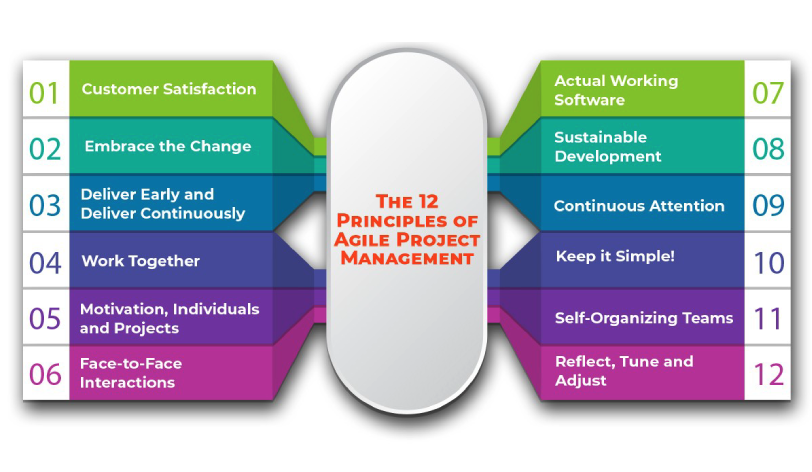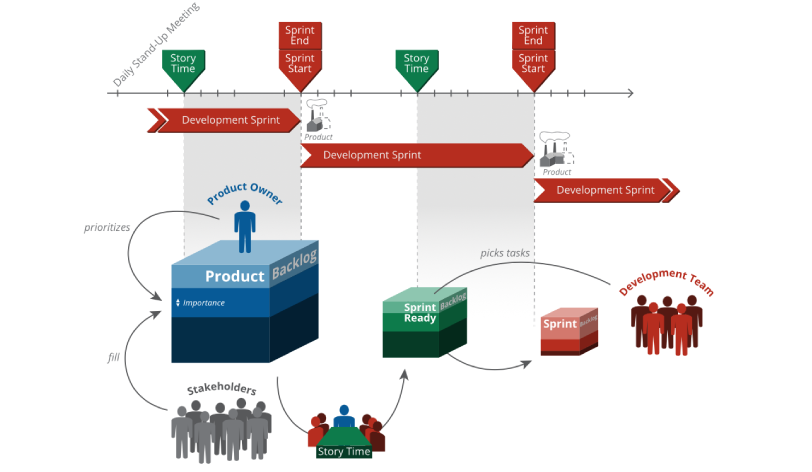In today’s fast-paced digital world, software development is no longer just about writing code. It’s about delivering value to the customer through quality software, in the shortest time possible. Agile methodologies offer a solution to this challenge by providing a flexible and collaborative approach to software development. In this post, we will explore the benefits of Agile, how to start, implement and strategies to be used, along with the tools that can be used.
What is Agile Methodology?
Agile methodology is a software development approach that emphasizes flexibility, collaboration, and iterative delivery of software. It is based on the Agile Manifesto, which outlines four values and twelve principles that guide the Agile approach.
The twelve principles of the Agile Manifesto are:

- Customer satisfaction through early and continuous delivery of valuable software.
- Welcome changing requirements, even in late development. Agile processes harness change for the customer’s competitive advantage.
- Deliver working software frequently, with a preference for the shorter timescale.
- Business people and developers must work together daily throughout the project.
- Build projects around motivated individuals. Give them the environment and support they need, and trust them to get the job done.
- The most efficient and effective method of conveying information to and within a development team is face-to-face conversation.
- Working software is the primary measure of progress.
- Agile processes promote sustainable development. The sponsors, developers, and users should be able to maintain a constant pace indefinitely.
- Continuous attention to technical excellence and good design enhances agility.
- Simplicity–the art of maximizing the amount of work not done–is essential.
- Self-organizing teams produce the best architectures, requirements, and designs.
- At regular intervals, the team reflects on how to become more effective, then tunes and adjusts its behavior accordingly.
The twelve principles of the Agile Manifesto include delivering working software frequently, collaborating with the customer throughout the project, and embracing change as a competitive advantage.
The Benefits of Agile Methodology
Agile methodology has several benefits that make it an attractive option for software development companies. These benefits include:
Faster time-to-market: Agile methodology emphasizes iterative delivery of software, which allows for faster time-to-market and quicker feedback loops.
Increased customer satisfaction: Agile methodology puts the customer at the center of the development process, ensuring that their feedback is incorporated into the software at every stage.
Improved quality: Agile methodology focuses on continuous integration and testing, which ensures that defects are caught early and fixed quickly.
Enhanced collaboration: Agile methodology promotes collaboration among team members, which leads to better communication, teamwork, and knowledge sharing.
Increased flexibility: Agile methodology is highly adaptable, allowing teams to respond quickly to changing requirements and market conditions.
How to Start with Agile Methodology
To start with Agile methodology, it’s important to first understand the principles and values that guide it. Next, you need to choose an Agile framework that works for your team, such as Scrum or Kanban.
Once you have chosen an Agile framework, you need to create a backlog of user stories that outline the features and functionality that the software should include. These user stories should be prioritized based on their importance to the customer.

The next step is to form a cross-functional team that includes developers, testers, and other stakeholders. This team should be self-organizing and have the autonomy to make decisions about how to implement the user stories.
Finally, you need to establish a sprint cadence, which is the length of time between iterations. Sprints are typically two to four weeks long and include planning, execution, and review phases.
How to Implement Agile Methodology
Implementing Agile methodology requires a shift in mindset and culture. The following strategies can help ensure a successful transition:
Educate the team: Provide training and resources to help team members understand the principles and values of Agile methodology.
Emphasize collaboration: Encourage team members to work together and communicate openly to promote knowledge sharing and teamwork.
Establish clear roles and responsibilities: Define the roles and responsibilities of team members and ensure that everyone understands their role in the development process.
Use metrics to measure success: Implement metrics that measure the team’s progress and success, such as velocity, burn-down charts, and cycle time.
Continuously improve: Embrace a culture of continuous improvement by regularly reviewing processes and identifying areas for improvement.
Tools for Agile Methodology
Several tools can be used to support Agile methodology, including:
JIRA: A project management tool that can be used for backlog management, sprint planning, and issue tracking.
Trello: A visual project management tool that allows teams to organize tasks, set priorities, and collaborate in real-time.
Asana: A project management tool that allows teams to track tasks, deadlines, and dependencies in one place.
GitHub: A code repository that allows teams to collaborate on code, track changes, and manage version control.
Slack: A messaging and collaboration tool that allows teams to communicate in real-time and share files and information.
Zoom: A video conferencing tool that allows teams to hold virtual meetings and collaborate in real-time, no matter where they are located.
Google Drive: A cloud-based document management system that allows teams to store and share files, collaborate on documents, and access information from anywhere.
Open Source vs. Paid Tools
There are several open-source tools available for Agile methodology, such as GitLab, OpenProject, and Taiga. These tools are free to use, but may not have all the features and functionality of paid tools. Paid tools, such as JIRA and Asana, typically offer more advanced features and support, but come with a cost.
When choosing between open-source and paid tools, it’s important to consider your team’s needs, budget, and long-term goals. Open-source tools may be a good option for small teams or startups with limited budgets, while paid tools may be a better option for larger teams or companies that require more advanced features and support.
Conclusion
Agile methodology offers a flexible and collaborative approach to software development that can help teams deliver high-quality software in a shorter time frame. By emphasizing customer collaboration, continuous improvement, and a culture of adaptability, Agile methodology can help teams stay competitive and respond quickly to changing market conditions.
To start with Agile methodology, it’s important to understand the principles and values that guide it, choose an Agile framework that works for your team, create a backlog of user stories, form a cross-functional team, and establish a sprint cadence.
To implement Agile methodology successfully, it’s important to educate the team, emphasize collaboration, establish clear roles and responsibilities, use metrics to measure success, and continuously improve.
Finally, there are several tools available to support Agile methodology, both open-source and paid. When choosing between tools, it’s important to consider your team’s needs, budget, and long-term goals.
If you’re interested in learning more about Agile methodology or how it can benefit your organization, please contact us to discuss how we can help.


